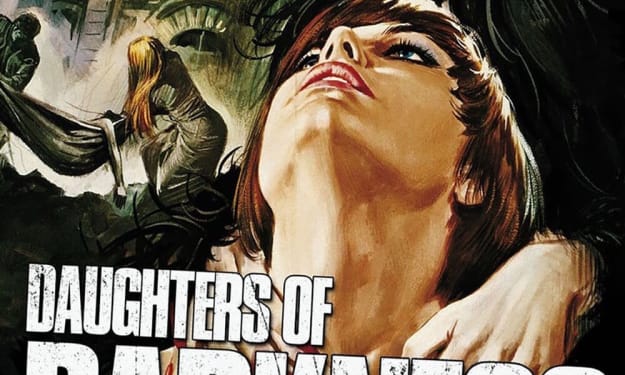Horror Classics: Dracula (1958)
The King is Back!

Well, I told you we'd be back with Dracula soon, and here we are! So far in the Dracula marathon on Horror Classics, we've covered:
This time around, we're covering 1958's Dracula starring Christopher Lee and Peter Cushing. This is going to be great!
The New Dracula

When Universal Studios released Dracula in 1931, it was a cultural hit with the public. The company quickly worked to put out a sequel (Dracula's Daughter) in 1936. Of course, then the Second World War happened and movie monsters were mostly on the outs as people were more concerned about what was happening on the frontlines - at least according to film studios.
This obviously didn't last long as the companies quickly realized that audiences NEEDED a form of escapist fantasy to get away from the day-to-day stresses of the time. With that in mind, movie monsters started making a comeback. 1943's Son of Dracula got a rather mixed response, but it was still positive enough to warrant a few other films that featured the Universal movie monsters; Dracula, Frankenstein, and the Wolfman did fairly well in their own right, but the crossovers that they did weren't as well received.
After 1945's House of Dracula, Count Dracula went into hibernation. That hibernation lasted 13 years before Hammer Studios came along and put a new Dracula film on the scene. This film starred Christopher Lee as the titular character and even now 66 years after its release it's still a favorite among horror fans.
Behind the Scenes of Hammer's Dracula
Production on Dracula began in 1957 at Bray Studios on a budget of around 81k Pounds. Given the small budget, Jimmy Sangster, who was the film's screenwriter, made a few changes - this is something I'm going to come back to later.
Casting was pretty easy for this one, Peter Cushing was hot off the proverbial press so-to-speak with the success that was Curse of Frankenstein the year before. He was subsequently cast as Prof. Van Helsing, a role he'd reprise in a few of the sequels.
Christopher Lee was likewise an obvious choice for the villainous Count Dracula. His imposing stature and piercing stare helped him chew up the scenery whenever he was on screen.
The Story
The story is a very loose adaptation of Bram Stoker's novel. Jonathan Harker travels to Transylvania, ostensibly to work as Dracula's librarian. He is actually there to end Dracula's reign of terror - to hunt and kill the vampire. Unfortunately for him, he becomes Dracula's victim instead. It falls to his friend and colleague Dr Van Helsing to take up the charge.
Dracula, meanwhile, has his eyes on Arthur Holmwood's wife, Mina. The two men have to work together to save Mina and rid the world of Dracula.
What I Liked about Hammer's First Dracula Outing

The set design is great and the various landscapes that we get to see are absolutely GORGEOUS! Performance-wise, I enjoyed every single one - even the minor characters of the innkeeper and barmaid make an impression. Some of the best acting in the film is purely through the actors' facial expressions and reactions to what's going on; it makes for a riveting watch - if you're in the right mood for it.
While Bela Lugosi might be forever known as the king of vampires, Christopher Lee's performance as the vile Count is just as iconic. He plays the part with just the right balance of menace and charm, but you know that he's got something going on behind his eyes.
As far as pacing goes, the film moves along nicely and gets from A to B with little difficulty. Now, the tone of the film is, surprisingly enough, very consistent. Tonal consistency is a fickle beast that's hard to tame in any genre, but horror films have a razor-thin line between seriousness and silliness that they have to walk. Stray too far to either side and the film falls apart because it's not what your audience is expecting. Thankfully, that's not a problem here.
What didn't Work So Well?
Truthfully, I didn't have all that many issues with the movie. I did find some of the physical acting to be a little overly dramatic but that's all.
The characters of the undertaker and border guard were clearly meant to be some kind of comic relief. Unfortunately, the humor falls flat - in both cases.
Changes, Changes, So Many Changes

So, we know the film is a loose adaptation of Bram Stoker's novel, but just how loose an adaptation is it?
- Jonathan Harker goes to Transylvania to take up work as Dracula's librarian. This is a cover to allow him to get close to, and kill the Count. So, the basic event (going to the Count) is there, but the motives are different from book to film.
- The relationships are switched around. Arthur Holmwood is now married to Mina and Jonathan is engaged to Lucy. Lucy is also Arthur's sister in this one.
- Dracula dies via exposure to sunlight instead of by two fatal knife wounds as he did in the book.
- Dracula also never transforms into a bat, wolf, or mist. In fact, the film acknowledges that idea as a common fantasy.
- Like the 1931 version, the bride sequence plays out very differently between the film and the book. This time around, we have one bride and when she bites Harker, we get the enraged Count of the book who tosses her around the room like a ragdoll.
- Dracula himself also moves much faster in this one than he did in previous incarnations which is unnerving in its own right.
There are other changes, and maybe I'll do a faithful adaptations piece that discusses the various changes that the different versions made. For now, however, I think we should move on.
Standouts
It's time to highlight some standout moments or performances. This is something I forgot to do in the previous instalment on Daughters of Darkness.
Christopher Lee

To say that Christopher Lee's portrayal of Dracula is iconic would be an understatement. He brought a sense of energy and menace to the role that nobody else has managed to do since. He also went on to film several more Dracula films - albeit reluctantly - for Hammer Studios throughout the 60s and early 70s. We'll discuss that another time, though.
Peter Cushing

Lee and Cushing became good friends throughout their work together, but while Lee hated being typecast, Cushing seemed to relish it. He brings such believability to his role as Van Helsing that you become truly invested in what he has to say. Like Lee, Cushing went on to reprise the role in a few other Hammer films.
Melissa Stribling
Melissa Stribling, who played Mina in the film, got some very...interesting advice from director Terence Fisher about the scene following her first encounter with Dracula. That advice was to imagine she'd just had the best sex she'd ever had. Well...

I leave it to you, the reader, to decide if she pulled it off or not.
About the Creator
Greg Seebregts
I'm a South African writer, blogger and English tutor; I've published 1 novel and am working on publishing a 2nd. I also write reviews on whatever interests me. I have a YouTube Channel as well where I review books, and manga and so on.






Comments
There are no comments for this story
Be the first to respond and start the conversation.